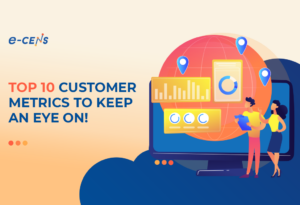Measuring your customer success metrics is one of the best ways to get a sense of how well your business is performing. Customer success is critical to a sustainable business strategy, especially in SaaS organizations.
Too many tracking techniques start and end with customer acquisition, with little to no monitoring of what occurs after a customer signs up. However, knowing your customer’s journey beyond their investment may have a significant impact on the strategies, goals, and priorities of your Customer Success (CS) team.
Customer success metrics are quantifiable measures that track and evaluate the success of the CS team. Monitoring the right metrics can help keep your business on track and make sure that your churn isn’t outweighing your growth, that your customers are happy with your product or service, and that you can see where your business is headed.
In this post, we will cover seven customer success metrics you should be tracking and how you can leverage collected data to gain a competitive advantage.
1. Customer Churn Rate (CCR)
Customer churn rate, also known as attrition rate, is the percentage of customers that stop doing business with your company over a specified period. Churn also refers to the number of subscribers who cancel or do not renew their subscription.
Importance of CCR: Understanding your customer churn is critical for assessing the effectiveness of your marketing initiatives and overall customer satisfaction. It provides valuable customer feedback on your products, services, pricing, employees, and competitors.
Formula: CCR = (# of lost customers / # of customers at the start of time period) x 100%
2. Customer Health Score (CHS)
The customer health score is a metric that evaluates whether a customer is healthy or at risk. A healthy customer is satisfied, uses your product regularly, promotes your product or service to others, and shows a low risk of churning. In contrast, an unhealthy customer may be dissatisfied with your product and may be considering switching to a competitor.
Importance of CHS: Tracking customer health scores is critical since it alerts your CS team when to intervene. It acts as an indicator of whether a customer will churn or renew. It notifies the team whenever a customer needs attention and helps determine the type of attention required.
Formula: Unlike many other metrics you’ll find in this list, the customer health score does not have a specific algorithm. Instead, it is determined by your industry, company, product, and customer.
3. Customer Lifetime Value (CLV)
Customer lifetime value is one of the most crucial customer success indicators that your company can track. It displays the total income you may expect from a single customer over the duration of their relationship with your business.
Importance of CLV: Knowing your CLV provides insight into how many customers you need to maintain growth. It also shows if you’re losing money on customer acquisition and whether there are opportunities to boost the revenue each customer contributes to your business. CLV promotes better decision-making by educating marketers to spend less time acquiring low-value consumers.
Formula: CLV = average purchase value x average purchase frequency rate x average customer lifespan
4. Customer Acquisition Cost (CAC)
Customer acquisition cost is the sum of all marketing and sales expenses incurred to acquire a client. It is one of the determining factors in whether your company has a successful business model capable of generating profits while keeping acquisition expenses low as you scale.
Importance of CAC: CAC is useful for determining the effectiveness of your customer acquisition plan, staying on track with your budget, and making informed decisions about where to invest your money. It also helps in optimizing marketing and sales efforts to focus on CLV.
Formula: CAC = cost of marketing and sales / # of new customers acquired
5. Customer Retention Cost (CRC)
Customer retention cost refers to the total amount spent to keep a customer, which includes customer success, engagement, training, and tools. Your CRC works in tandem with your CLV and CAC to provide a more comprehensive view of your entire customer value and how it aligns with your customer success activities.
Importance of CRC: CRC helps businesses identify and invest in the best customer success programs. While you may be eager to plan and launch new projects, you must ensure that you are spending your money wisely. By assessing CRC, your company can make sound investment decisions by weighing the possible cost of customer retention against the potential revenue you can generate from a new product, feature, or service.
Formula: CRC = sum of all customer expenses / # of customers
6. Net Promoter Score (NPS)
The net promoter score is a metric that helps assess customer loyalty and satisfaction by asking customers a one-question survey about how likely they are to recommend your product or service to a friend. Then, the respondents are classified as Promoters, Passives, or Detractors.
These responses are tabulated and used to generate a score ranging from -100 to +100. The higher the NPS, the better for your business. Customers who are more inclined to recommend you are more loyal to your brand and will bring you more clients.
Importance of NPS: NPS is straightforward, easy to compare, and serves as a gauge of brand performance rather than feedback on a single transaction. NPS enables you to identify your most loyal consumers and use them as a basis for product development.
Formula: NPS = % of promoters – % of detractors
7. Customer Satisfaction Score (CSAT)
The customer satisfaction score assesses how satisfied a customer is with a business, product, or interaction. It is similar to NPS, but instead of asking participants to rate their likelihood of recommending your brand or product to others, CSAT just asks them to rate their experience with your business. This provides your business an overview of how customers feel after interacting with the customer support or success team.
Importance of CSAT: Tracking changes in customer satisfaction can help you predict consumer behavior and revenue returns. It helps you identify loyal customers who are good candidates for upselling pitches. It also shows you which customers are dissatisfied with your business, enabling you to set things right with them and protect your brand image.
Formula: CSAT = (# of satisfied responses / # of total survey responses) x 100%
Conclusion
After identifying the most crucial customer success metrics to track, the next step is determining how you will track these metrics. The apps and tools you use today most likely have the data you need to calculate these metrics, but it’s vital to reconcile all the data in a centralized platform to facilitate better optimization.
At e-CENS, we empower every organization to be data-driven—to make the most out of all collected data to improve the customer experience and achieve customer success. Contact us today if you want to kickstart your customer success strategy and take your company to new heights.




